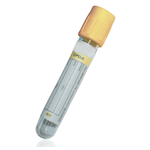Suitable Specimen Types
- Serum
- EDTA Plasma
- Li Hep Plasma
Sample Processing in Laboratory
UsualSample Preparation
Centrifuge. For mass spec testosterone, DO NOT separate serum into Impeco tubes as this causes interference with the assay. Send primary tubes to QE for analysis.Turnaround Time
24 hours (immunoassay), 5 working days (mass spec)Sample Stability
4 ºCTestosterone
General Information
Androgens are a group of steroids which cause masculinisations of the genital tract and the development and maintenance of male secondary sexual characteristics. They also contribute to muscle bulk, bone mass, libido and sexual performance in men. Testosterone is the major androgen secreted by the Leydig cells of the testes, and its production increases during puberty. Women produce about 5% to 10% as much testosterone as men. Testosterone directly effects some aspects of secondary sexual characteristics such as deepening of voice, increase of muscle mass and libido and also has some indirect effects in tissue with high 5alpha-reductase activity, where it serves as a prohormone to formation of dihydrotestosterone.
Testosterone may be requested, together with measurement of FSH and LH, in males for invesigation of sexual dysfunction or infertility.
In the female, testosterone is secreted by the ovary (60%) and is also derived from the peripheral conversion of androstenedione (40%) which is secreted in equal amounts by the ovary and adrenal. Hence, elevated serum testosterone levels can either be of ovarian or adrenal origin. Testosterone may be requested, together with other endocrine investigations, for the investigation of secondary amenorrhea, infertility or hirsutism/virilization. All female testosterone results by immunoassay that are above the reference range (>1.8 nmol/L) are automatically confirmed by mass spectrometry.
Patient Preparation
None
Notes
Testosterone in adults is measured using an automated Abbott Alinity immunoassay.
For female adult patients where the immunoassay result is above the reference range (>1.8 nmol/L) mass spectrometry analysis is automatically added for confirmation this is to rule out any potential interferences e.g similarly structured steroid compounds. Where two testosterone results are reported please use the mass spectrometry result to monitor patients.
Testosterone in paediatric patients (<16y) is measured using mass spectrometry.
All referral samples from external laboratories, regardless of age, are measured by mass spectrometry.
If mass spectrometry analysis is required outside the above parameters, please contact the Duty Biochemist on ext.42198
Reference Range
Adults (Alinity immunoassay):
Female: <1.9 nmol/L
Male aged 18-49 years: 8.3 - 30.2 nmol/L
Male aged >50 years: 7.7 - 24.8 nmol/L
Adults (mass spectrometry):
Female: <1.9 nmol/L
Male: 7.0-27.0 nmol/L
Paediatrics:
| Group | Testosterone (nmol/L) |
| Neonates | Not reported (can be elevated during year 1) |
| Female Tanner 1 | <0.6 |
| Male Tanner 1 | <0.7 |
Reference for mass spectrometry reference ranges:
- Kushnir et al (2010). Liquid Chromatography–Tandem Mass Spectrometry Assay for Androstenedione, Dehydroepiandrosterone, and Testosterone with Pediatric and Adult Reference Intervals. Clinical Chemistry 2010:56;1138–77.
Source of Reference Range
Immunoassay (Abbott Laboratories), Mass spectrometry (Kushnir et al 2010)Specifications
- EQA Scheme?: Yes
- EQA Status: NEQAS
